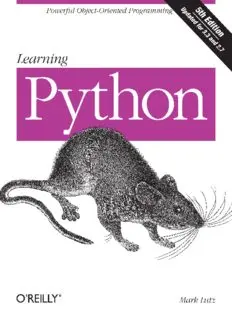
Learning Python: powerful object-oriented programming PDF
Preview Learning Python: powerful object-oriented programming
FIFTH EDITION Learning Python Mark Lutz Beijing • Cambridge • Farnham • Köln • Sebastopol • Tokyo Learning Python, Fifth Edition by Mark Lutz Copyright © 2013 Mark Lutz. All rights reserved. Printed in the United States of America. Published by O’Reilly Media, Inc., 1005 Gravenstein Highway North, Sebastopol, CA 95472. O’Reilly books may be purchased for educational, business, or sales promotional use. Online editions are also available for most titles (http://my.safaribooksonline.com). For more information, contact our corporate/institutional sales department: 800-998-9938 or [email protected]. Editor: Rachel Roumeliotis Indexer: Lucie Haskins Production Editor: Christopher Hearse Cover Designer: Randy Comer Copyeditor: Rachel Monaghan Interior Designer: David Futato Proofreader: Julie Van Keuren Illustrator: Rebecca Demarest June 2013: Fifth Edition. Revision History for the Fifth Edition: 2013-06-07 First release See http://oreilly.com/catalog/errata.csp?isbn=9781449355739 for release details. Nutshell Handbook, the Nutshell Handbook logo, and the O’Reilly logo are registered trademarks of O’Reilly Media, Inc. Learning Python, 5th Edition, the image of a wood rat, and related trade dress are trademarks of O’Reilly Media, Inc. Many of the designations used by manufacturers and sellers to distinguish their products are claimed as trademarks. Where those designations appear in this book, and O’Reilly Media, Inc., was aware of a trademark claim, the designations have been printed in caps or initial caps. While every precaution has been taken in the preparation of this book, the publisher and authors assume no responsibility for errors or omissions, or for damages resulting from the use of the information con- tained herein. ISBN: 978-1-449-35573-9 [QG] 1370970520 To Vera. You are my life. Table of Contents Preface .................................................................. xxxiii Part I. Getting Started 1. A Python Q&A Session ................................................... 3 Why Do People Use Python? 3 Software Quality 4 Developer Productivity 5 Is Python a “Scripting Language”? 5 OK, but What’s the Downside? 7 Who Uses Python Today? 9 What Can I Do with Python? 10 Systems Programming 11 GUIs 11 Internet Scripting 11 Component Integration 12 Database Programming 12 Rapid Prototyping 13 Numeric and Scientific Programming 13 And More: Gaming, Images, Data Mining, Robots, Excel... 14 How Is Python Developed and Supported? 15 Open Source Tradeoffs 15 What Are Python’s Technical Strengths? 16 It’s Object-Oriented and Functional 16 It’s Free 17 It’s Portable 17 It’s Powerful 18 It’s Mixable 19 It’s Relatively Easy to Use 19 It’s Relatively Easy to Learn 20 It’s Named After Monty Python 20 v How Does Python Stack Up to Language X? 21 Chapter Summary 22 Test Your Knowledge: Quiz 23 Test Your Knowledge: Answers 23 2. How Python Runs Programs ............................................. 27 Introducing the Python Interpreter 27 Program Execution 28 The Programmer’s View 28 Python’s View 30 Execution Model Variations 33 Python Implementation Alternatives 33 Execution Optimization Tools 37 Frozen Binaries 39 Future Possibilities? 40 Chapter Summary 40 Test Your Knowledge: Quiz 41 Test Your Knowledge: Answers 41 3. How You Run Programs ................................................. 43 The Interactive Prompt 43 Starting an Interactive Session 44 The System Path 45 New Windows Options in 3.3: PATH, Launcher 46 Where to Run: Code Directories 47 What Not to Type: Prompts and Comments 48 Running Code Interactively 49 Why the Interactive Prompt? 50 Usage Notes: The Interactive Prompt 52 System Command Lines and Files 54 A First Script 55 Running Files with Command Lines 56 Command-Line Usage Variations 57 Usage Notes: Command Lines and Files 58 Unix-Style Executable Scripts: #! 59 Unix Script Basics 59 The Unix env Lookup Trick 60 The Python 3.3 Windows Launcher: #! Comes to Windows 60 Clicking File Icons 62 Icon-Click Basics 62 Clicking Icons on Windows 63 The input Trick on Windows 63 Other Icon-Click Limitations 66 vi | Table of Contents Module Imports and Reloads 66 Import and Reload Basics 66 The Grander Module Story: Attributes 68 Usage Notes: import and reload 71 Using exec to Run Module Files 72 The IDLE User Interface 73 IDLE Startup Details 74 IDLE Basic Usage 75 IDLE Usability Features 76 Advanced IDLE Tools 77 Usage Notes: IDLE 78 Other IDEs 79 Other Launch Options 81 Embedding Calls 81 Frozen Binary Executables 82 Text Editor Launch Options 82 Still Other Launch Options 82 Future Possibilities? 83 Which Option Should I Use? 83 Chapter Summary 85 Test Your Knowledge: Quiz 85 Test Your Knowledge: Answers 86 Test Your Knowledge: Part I Exercises 87 Part II. Types and Operations 4. Introducing Python Object Types ......................................... 93 The Python Conceptual Hierarchy 93 Why Use Built-in Types? 94 Python’s Core Data Types 95 Numbers 97 Strings 99 Sequence Operations 99 Immutability 101 Type-Specific Methods 102 Getting Help 104 Other Ways to Code Strings 105 Unicode Strings 106 Pattern Matching 108 Lists 109 Sequence Operations 109 Type-Specific Operations 109 Table of Contents | vii Bounds Checking 110 Nesting 110 Comprehensions 111 Dictionaries 113 Mapping Operations 114 Nesting Revisited 115 Missing Keys: if Tests 116 Sorting Keys: for Loops 118 Iteration and Optimization 120 Tuples 121 Why Tuples? 122 Files 122 Binary Bytes Files 123 Unicode Text Files 124 Other File-Like Tools 126 Other Core Types 126 How to Break Your Code’s Flexibility 128 User-Defined Classes 129 And Everything Else 130 Chapter Summary 130 Test Your Knowledge: Quiz 131 Test Your Knowledge: Answers 131 5. Numeric Types ....................................................... 133 Numeric Type Basics 133 Numeric Literals 134 Built-in Numeric Tools 136 Python Expression Operators 136 Numbers in Action 141 Variables and Basic Expressions 141 Numeric Display Formats 143 Comparisons: Normal and Chained 144 Division: Classic, Floor, and True 146 Integer Precision 150 Complex Numbers 151 Hex, Octal, Binary: Literals and Conversions 151 Bitwise Operations 153 Other Built-in Numeric Tools 155 Other Numeric Types 157 Decimal Type 157 Fraction Type 160 Sets 163 Booleans 171 viii | Table of Contents
